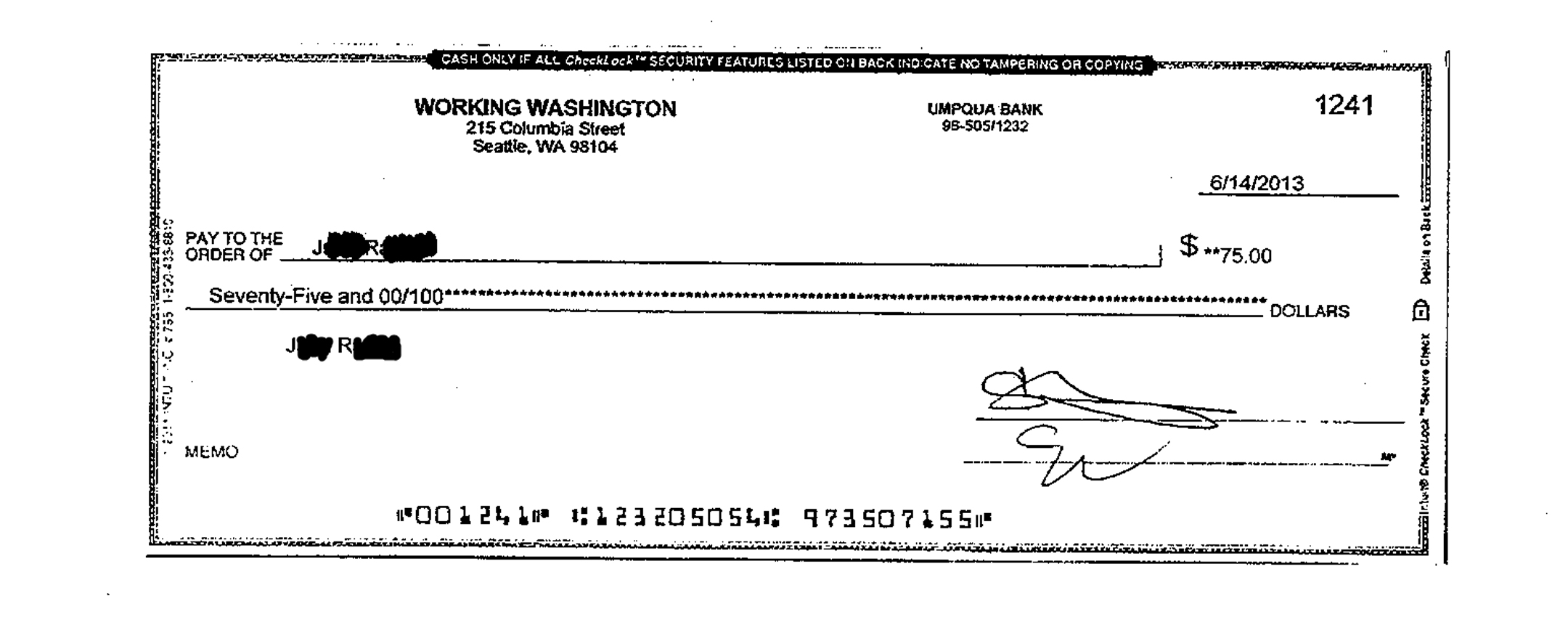Washington State has the fourth highest unionization rate in the country and, in recent months, has seen a high level of activity by union and alternative labor (alt-labor) groups. The Seattle area hosted a number of fast food strikes over the summer, as well as follow-up strikes targeting Subway. In recent local elections, unions and alt-labor groups backed a $15 minimum wage initiative which Jonathan Martin of The Seattle Times noted would encourage union organizing.
Just recently, Steven Greenhouse of The New York Times noted that “many within labor are looking to Washington State as a model because of all the union community activity there.”
Working Washington is one of the primary organizations behind alt-labor activity in the Puget Sound region. The group describes itself as “a coalition of individuals, neighborhood associations, immigrant groups, civil rights organizations, people of faith, and labor united for good jobs and a fair economy.”
Government records indicate, however, that the group is funded heavily, and perhaps exclusively, by the Service Employees International Union (SEIU). Further research indicates that Working Washington not only organized recent fast food protests, but directly paid workers to participate.
In and of itself, knowing the source of Working Washington’s funding does nothing to undermine the legitimacy of the group’s arguments. However, it is important to realize that protests billed as grassroots uprisings by workers may be anything but. Given the tendency of labor unions to use paid protestors, upcoming Black Friday protestsby planned by OUR Walmart, an alt-labor group tied to the United Food and Commercial Workers Union (UFCW), should be taken with a grain of salt.
Background
Working Washington was created in 2011 and immediately began associating itself with the Occupy Wall Street movement in the Puget Sound region.
An article on the group’s website declared in October of 2011, “Occupy Seattle, We’re With You.” The following December, Emily Heffter of The Seattle Times examined Working Washington’s role in Occupy Seattle, concluding that “Working Washington was indistinguishably entwined with the Occupy movement.”
Heffter explained how Working Washington co-opted local Occupy activity, pointing out that “Working Washington—not Occupy—organized some of the most prominent local protests.” The article also examined the organization’s ties with the SEIU, noting that the two groups shared office space and staff, and concluded that “Working Washington is not truly grass-roots.”
Several months later, an investigative piece by The Daily Caller’s Richard Pollock found that Working Washington’s website is hosted by an SEIU server.
More recently, Working Washington worked hard to pass a $15 minimum wage and employment standardsinitiative in the City of SeaTac which was written to incentivize union organizing. Working Washington contributed about $230,000 in cash to the campaign supporting the initiative and provided in-kind donations and staff time valued at an additional $200,000, according to reports filed with the state Public Disclosure Commission.
In addition, local news outlets reported that Working Washington was involved in organizing Puget Sound-area fast food protests over the summer.
New Research
While earlier research indicated close ties between Working Washington and the SEIU, government reports show that Working Washington executives are all paid SEIU employees. The reports also indicate that SEIU national headquarters provides significant monthly funding to Working Washington.
Furthermore, documents uncovered in recent litigation related to the summer’s fast food strikes show that Working Washington paid Subway workers to participate in the strikes, undermining the narrative advanced by labor groups that the strikes were grassroots efforts started by workers.
Under the Labor Management Reporting and Disclosure Act (LMRDA), private sector labor unions are requiredto annually report certain information to the federal Department of Labor (DOL). These LM-2 forms contain information about union staff, finances and membership, and are referenced frequently below. Copies of the full forms as well as directions for accessing the data directly are included at the end of the article.
Leadership
All of Working Washington’s officers appear to have full-time jobs working for SEIU locals.
Working Washington is registered with the Washington Secretary of State as a non-profit organization, though it does not appear to have non-profit status with the IRS. The “Governing Persons” listed for Working Washington include:
- President: Sergio Salinas. According to the union’s website, Salinas is also the President of SEIU Local 6.
- Treasurer: Ana Crapsey. The 2012 LM-2 report to the DOL for Service Employees Leadership Council 14, lists Crapsey as the finance and operations manager.
- Director: Andrew Beane. The 2012 LM-2 report for SEIU Local 775 lists Andrew Beane simply as “staff,” though his $92,155 salary indicates he occupies a position of some significance.
- Secretary: David Rolf. Rolf also serves as the President of SEIU 775, according to the union’s website.
Funding
In addition to being staffed by SEIU officials, federal LM-2 reports indicate that Working Washington receives substantial, regular funding from SEIU national headquarters, routed through the state-level SEIU.
The 2011 and 2012 LM-2s for Service Employees Leadership Council 14, based in Seattle, indicate that the Council received monthly funds from the SEIU’s national headquarters earmarked for the “Working WA program.” The reports indicate that the same amounts were then issued monthly to Working Washington by the Council for the purpose of “community organizing.”

SEIU Council 14 2011 LM2 – Working WA Money In
SEIU Council 14 2011 LM2 – Working WA Money Out
SEIU Council 14 2012 LM2 – Working WA Money In
SEIU Council 14 2012 LM2 – Working WA Money Out
SEIU Leadership Council 14’s LM-2s classify the money received from SEIU headquarters for the “Working WA program” under “other receipts.” The LM-2s classify Council 14’s expenditures to Working Washington as “political activities and lobbying.”
All told, the national SEIU funneled $3,652,340 in regular, monthly payments through SEIU Leadership Council 14 to Working Washington from 2011-2012.
Paid to Protest?
The Seattle area saw three waves of fast food protests this year: the first in May, the second in August and the third in September.
Some news outlets reported that a group called “Good Jobs Seattle” was behind the protests, while othersreported that they were orchestrated by Working Washington.
There appears to be little difference. In all likelihood, Good Jobs Seattle is simply the name of the campaign created by Working Washington. Working Washington’s website openly states that Good Jobs Seattle is “supported” by Working Washington and other labor-affiliated groups.
Furthermore, the Seattle PI reported that Nathan Jackson and Sage Wilson were key associates of Good Jobs Seattle. Wilson is the press contact for Working Washington. Also, both Wilson and Jackson are employees of SEIU Local 775, according to the union’s 2012 LM-2.
As a Subway worker in Seattle, Carlos Hernandez participated in both of the Working Washington-organized fast food strikes in May and August, gaining a reputation as something of an activist. In September, however, Hernandez was fired.
Working Washington immediately pounced on Hernandez’ firing and accused his employer of illegally retaliating against him for his participation in the protests. While the owner of the local Subway franchise denied the accusation, Working Washington filed charges against Subway with the National Labor Relations Board (NLRB).
At the same time, Working Washington organized a third wave of protests targeting local Subway outlets, this time demanding that Hernandez be given his old job back.
Robert Braun of the Braun Consulting Group is currently representing Subway in the complaint before the NLRB. In the process of litigating the complaint, Braun discovered that Subway workers were paid by Working Washington to participate in the earlier protests, and obtained a copy of a check for $75 paid by Working Washington to a striking Subway employee.
A redacted copy of the check was made available to the Freedom Foundation upon request and can be viewed below.

While the scope of such activity is impossible to verify, the existence of the practice significantly undermines the perception of the protests as a spontaneous, grassroots movement.
Conclusion
As one of the more prominent and active alt-labor groups in the state, it is important to know the extent of Working Washington’s ties to the SEIU, especially since no formal relationship between the groups is publicly acknowledged.
Working Washington takes a number of positions on policy and other issues. The validity of those positions is not necessarily undermined by the fact that they are funded directly by the SEIU. However, the blurred lines between Working Washington and the SEIU must be borne in mind when Working Washington claims to be operating in the interests of workers. As the organization’s involvement with Proposition 1 in the City of SeaTac indicates, sometimes a policy which appears to be about workers may really be more about union organizing.
Furthermore, preliminary research indicates that the Working Washington model, whereby the SEIU directly funds separate front-groups to engage in frontline activism, is being used in states beyond Washington. Such activity may run afoul of the Labor Management Reporting and Disclosure Act requirements.
Lastly, and significantly, the fact that the SEIU, through Working Washington, is paying workers to protest calls into question the validity of similar union-organized minimum wage protests nationwide. If such activity is not truly grassroots but manufactured, the question must be asked: What’s in it for the unions?
Full LM-2 Forms
SEIU Council 14 2011 LM2
SEIU Council 14 2012 LM2
SEIU Local 6 2012 LM2
SEIU Local 775 2012 LM2
Accessing LM-2s on the DOL Website:
- Go to: http://kcerds.dol-esa.gov/query/getOrgQry.do
- For the “State” field, select “Washington” from the dropdown menu.
- Click the “Submit” button at the bottom of the page.
- The resulting page contains a list of all of the unions required to file LM-2 forms in Washington. Only unions representing private sector workers must file LM-2s. Public sector unions in Washington, like the Washington Federation of State Employees and the Washington Education Association, are under no obligations to report financial, membership, or any other data.










